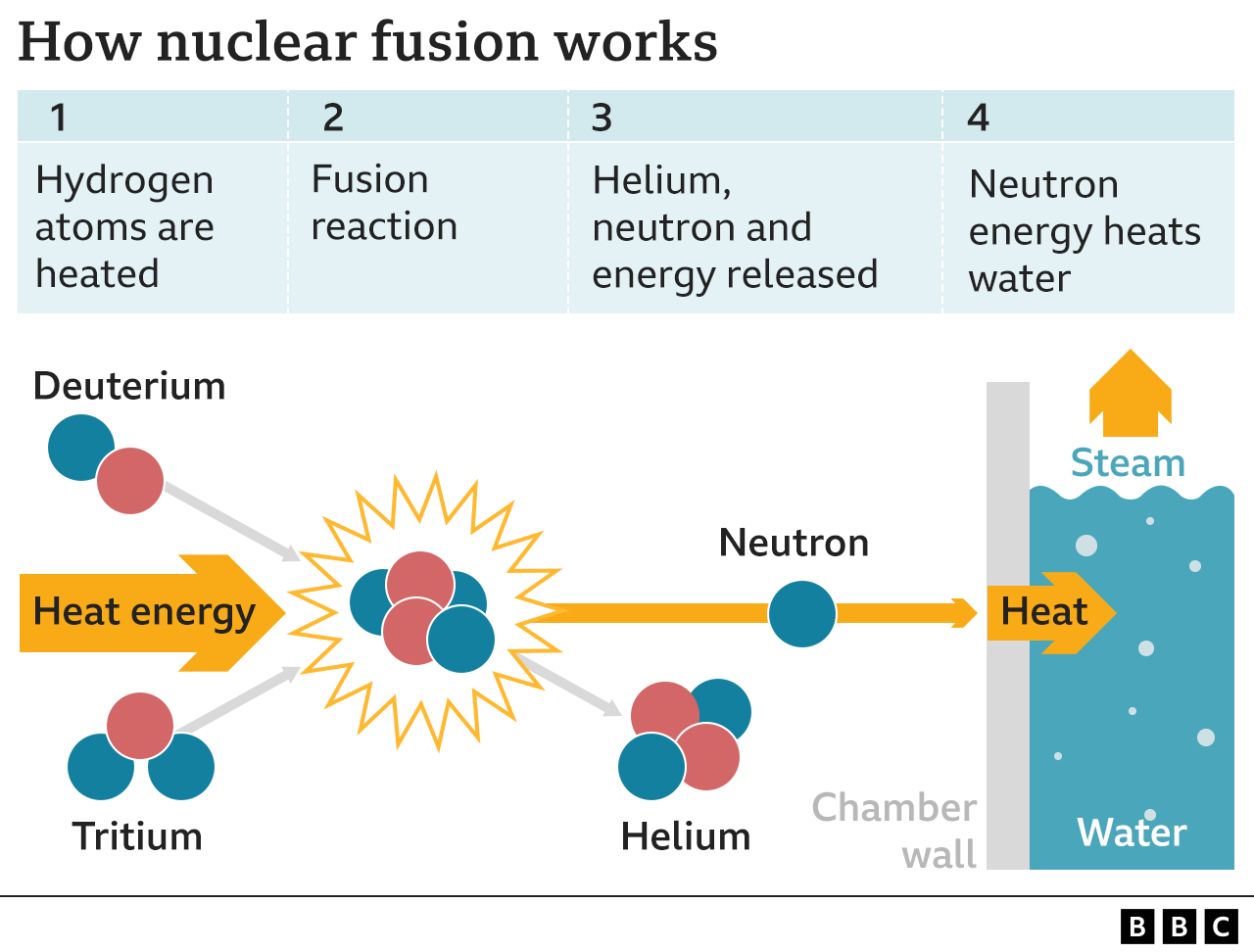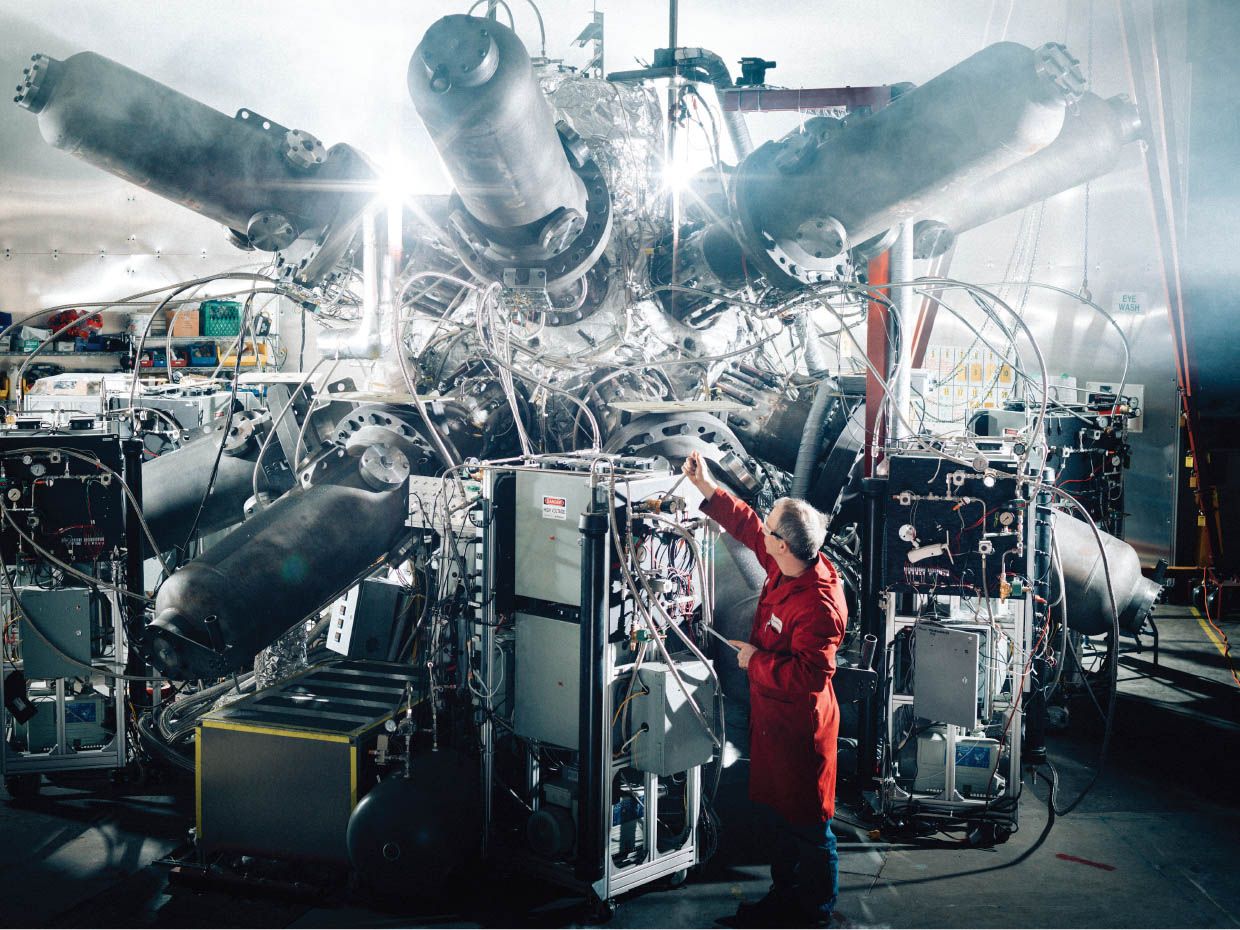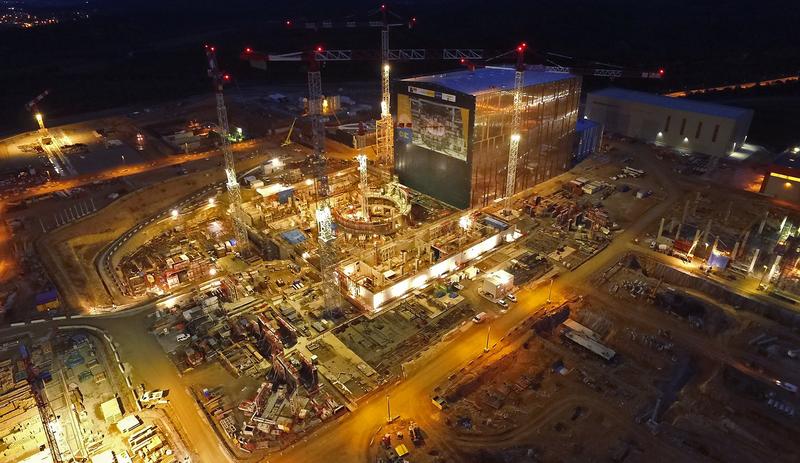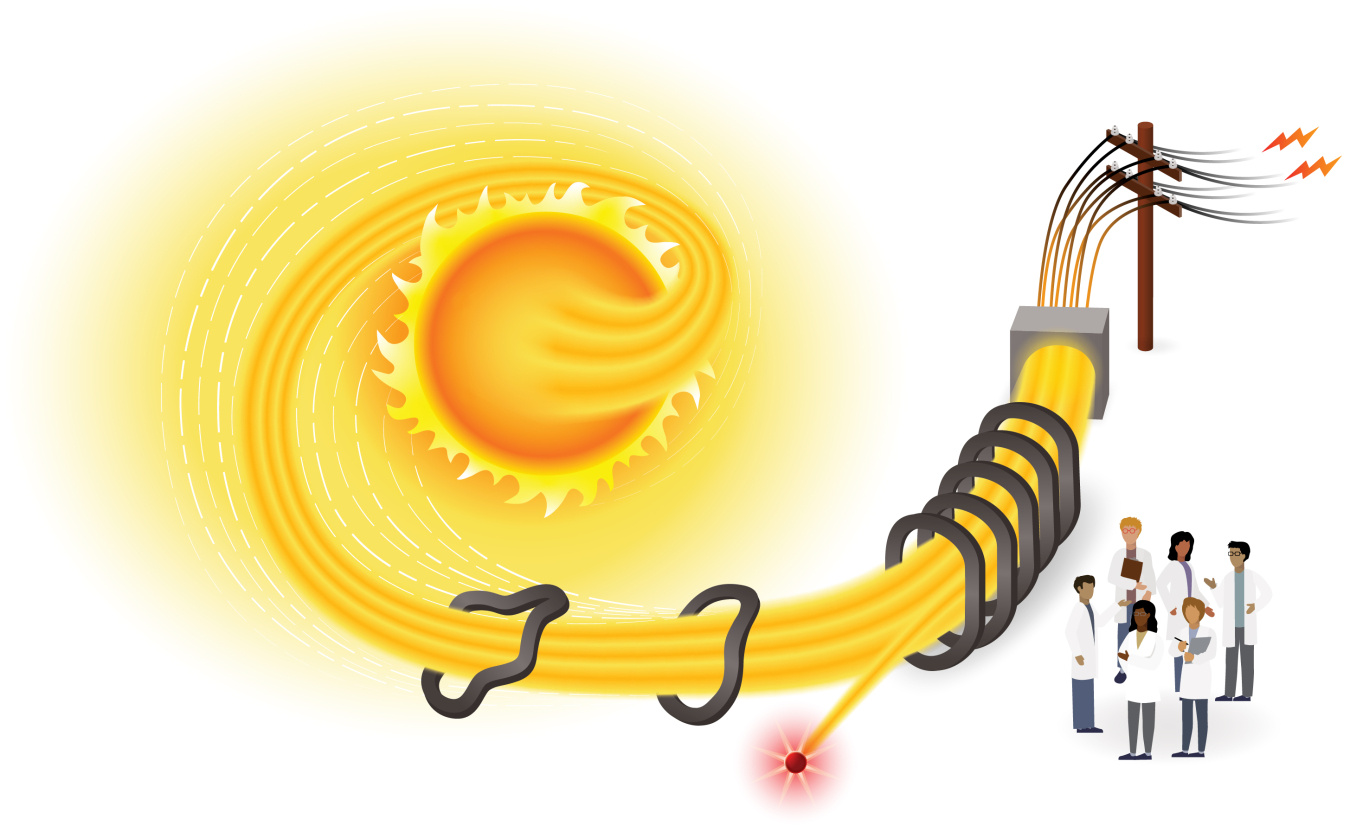Starting with the question for all you science newbies what is Fusion Power and why is it one of the most important aspects of the future?
What is Nuclear Fusion Power?
The process of fusion powers the Sun and stars as hydrogen atom’s fuse together to form helium, and matter is converted into energy . Hydrogen, heated to very high temperatures changes from a gas to a plasma in which the negatively-charged electrons are separated from the positively-charged atomic nuclei (ions).
Normally, fusion is not possible because the strongly repulsive electrostatic forces between the positively charged nuclei prevent them from getting close enough together to collide and for fusion to occur. However, if the conditions are such that the nuclei can overcome the electrostatic forces to the extent that they can come within a very close range of each other, then the attractive nuclear force (which binds protons and neutrons together in atomic nuclei) between the nuclei will outweigh the repulsive (electrostatic) force, allowing the nuclei to fuse together.
Such conditions can occur when the temperature increases, causing the ions to move faster and eventually reach speeds high enough to bring the ions close enough together. The nuclei can then fuse, causing a release of energy.

How this concept can change the Future
This futuristic project of producing energy offers advantages that not even the Nuclear reactors today or Renewable sources poses.
With no carbon emissions they safely release by-products that cant harm the environment in any kind. There is no radioactive waste by-product from the fusion reaction. Only reactor components become radioactive; the level of activity depends on the structural materials used.
Energy efficient – One kilogram of fusion fuel could provide the same amount of energy as 10 million kilograms of fossil fuel. Designed to produce a continuous supply of large amounts of electricity. Once established in the market, costs are predicted to be broadly similar to other energy sources .While times passes it would become even cheaper than the other sources .There is no radioactive waste by-products.
Safety also as one of the biggest concerns ,for example like in a nuclear accident is not possible when it comes to a fusion reactor. The amounts of fuel used in fusion reactors and devices are very small which means there is no risk of a runaway reaction which could lead to a potential meltdown reaction.
Is it science fiction or is it available?
For all of you science fiction lovers ,this isn’t only a dream but it’s a valid project and concept that’s been around here for almost a 100 years.
Quick History

With its beginning in the early 1920-1930s. Following Eddington’s paper ,Robert d’Escourt Aktinson and Fritz Houtermans provided the first calculations of the rate of the nuclear fusion in stars. With the idea of understanding what fuels the starts and the potential of that energy .Almost ten years into the project ,Ernest Rutherford made a giant breakthrough which showed the fusion of deterium into helium, and observed the enormous effect that was produced during this process.
The period of the 1950s was marked with the enter of the first fusion machines .In the hopes of replicating the process of the suns nuclear fusion on Earth .it lead to the release od the Tokamak(soviet scientists Andrei Sakharov and Igor tamm).Which was immediately followed by Lyman Spitzer’s concept for the stellarator .By the end of the 1950s the concept of the Tokamak was a more efficient concept so the Stellarator was dismissed.
1970-1980s This period was marked with the release of the designs of JET and the concept and beginning for today’s most important project on the Planet when it comes to Fusion power and that’s ITER.
The first concept and idea was the release of the Joint European Torus(JET) in 1973.With the green signal given the European commission started the construction of JET ,which became the largest operational magnetic confinement plasma physics experiment .With its completion in the 1983 it achieved the first plasmas.JET has made major advances in the science and engineering of fusion. Its success has led to the construction of the first commercial-scale fusion machine, ITER, and has increased confidence in the Tokamak as a design for future fusion power plants.
A quick chronological aspect of the JET
- 1978 JET construction starts
- 1983 First plasma in JET
- 1991 First experiments with tritium
- 1997 High performance full deuterium-tritium experiments. JET achieves world record fusion power of 16.1 MW.
- 2009 – 10 JET installs a new beryllium/tungsten plasma facing wall to test this configuration for ITER.
- 2019 – 20 Preparations well advanced for new deuterium-tritium experiments, designed to sustain high fusion performance for longer periods.
ITER as the most important project till today

The idea of making a collaborative international project to develop fusion energy gave birth to the ITER in 1985.
The idea of Harnessing fusion’s power is the goal of ITER, which has been designed as the key experimental step between today’s fusion research machines and tomorrow’s fusion power plants.
ITER (“The Way” in Latin) is one of the most ambitious energy projects in the world today .ITER will be the first fusion device to maintain fusion for long periods of time. It will be the first fusion device to test the integrated technologies, materials, and physics regimes necessary for the commercial production of fusion-based electricity .
The ITER Members China, the European Union, India, Japan, Korea, Russia and the United States have combined the resources to conquer one of the greatest frontiers in science—reproducing on Earth the boundless energy that fuels the Sun and the stars .With the collaboration of 35 nations worldwide with the experimental campaign that will be carried out at the ITER is crucial to advancing fusion science and preparing the way for the future power of tomorrow.
What is the next step for ITER

To understanding what are ITER-s goals .You have to understand the basics rules of the concept of energy production and the Fusion energy gain factor .This concept is composed out of two important parts that are called The fusion gain factor and Scientific breakeven .A fusion energy gain factor, usually expressed with the symbol Q, is the ratio of fusion power produced in a nuclear fusion reactor to the power required to maintain the plasma in steady state. The condition of Q = 1, when the power being released by the fusion reactions is equal to the required heating power, is referred to as breakeven, or in some sources, scientific breakeven.
Understanding the gain factor
Soo we have to understand the amount energy that goes into a fusion reactor ,and how much enegry comes out.
The equation is : Q =
The point where Q reaches 1 as said above is called breakeven for example .
As of 2021, the record for Q is held by the National Ignition Facility in the US, at Q = (1.35 MW)/(1.9 MW) ≈ 0.70, first attained in August 2021.Which means Q = 0.70
At the peak of its technology the ITER is designed to produce plasmas having Q ≥ 10: meaning that injecting 50 megawatts of heating power into the plasma will produce a fusion output of at least 500 megawatts. This is meant to happen by the end of 2035.These experiments will bring us into the range of self-heating plasmas (or ignition as it is called)
ITER’s mission
Now as we understand what are the capabilities of energy production from the International Thermonuclear Experimental Reactor we can talk about what it offers and the next steps.
1) Energy production
First and most important thing is the Energy production as said above,which will be able to produce 500 MW of fusion power .With its ten-fold return of energy (Q=10) or 500 MW of fusion power from 50 MW if input heating power .ITER will not capture the energy it produces as electricity, but—as first of all fusion experiments in history to produce net energy gain—it will prepare the way for the machine that can.
2) The demonstration of integrated operation of technologies for a fusion power plant
ITER will bridge the gap between today’s smaller-scale experimental fusion devices and the demonstration fusion power plants of the future. Scientists will be able to study plasmas under conditions similar to those expected in a future power plant and test technologies connected to it.
3) Sustained deuterium-tritium plasma in which the reaction is sustained trough IN (internal heating)
Scientists are confident that the plasmas in ITER will not only produce much more fusion energy, but will remain stable for longer periods of time.
4) The testing of tritium breeding
One of the missions for the later stages of ITER operation is to demonstrate the feasibility of producing tritium within the vacuum vessel. The world supply of tritium (used with deuterium to fuel the fusion reaction) is not sufficient to cover the needs of future power plants.
5)The evolution of safety hazards of a fusion device
One of the primary goals of ITER operation is to demonstrate the control of the plasma and the fusion reactions with negligible consequences to the environment.
Fusion reactions depend on the continuous input of fuel, and the process is highly sensitive to any variation in working conditions. Given that a fusion reaction could come to a halt within seconds, the process is inherently safe. “Fusion is a self-limiting process: if you cannot control the reaction, the machine switches itself off,” added and explained Sehila Gonzales de Vicenete ,Nuclear Fusion Physicist at the IAEA( International Atomic Energy Agency).
Conclusion on Fusion research today

A long-standing quip about fusion points out that, since the 1970s, commercial deployment of fusion power has always been about 40 years away. While there is some truth in this, many breakthroughs have been made, particularly in recent years, and there are a number of major projects under development that may bring research to the point where fusion power can be commercialized.
The use of fusion power plants could substantially reduce the environmental impacts of increasing world electricity demands since, like nuclear fission power, they would not contribute to acid rain or the greenhouse effect. Fusion power could easily satisfy the energy needs associated with continued economic growth, given the ready availability of fuels.
As Fusion Research continues and evolves the capabilities and potential will rise and lead us more to being closer to a Futuristic Type one Civilization .While the fusion power concept clearly has much to offer when the technology is eventually developed and given the commercial deployment ,the problems associated with it also need to be addressed if it is to become a widely used future energy source.
When will it be available, depends from the amount of testing and research together with the financial founding too .The only thing we can do now is hope it will be here between the period of 2035-2050.
- Market Capitalization (explained) - November 8, 2022
- Best affordable graphics cards in 2022(guide) - November 8, 2022
- Hydro energy (explained) - November 8, 2022
